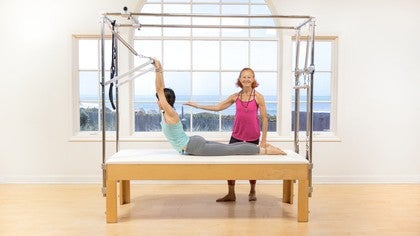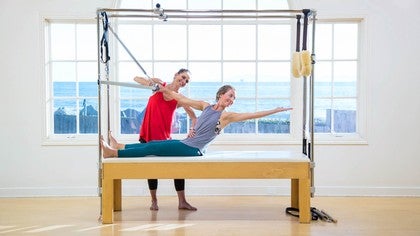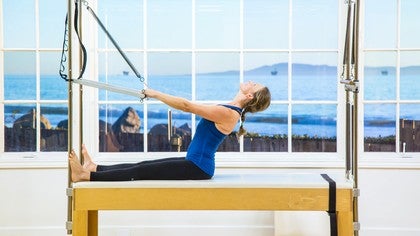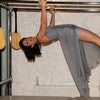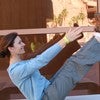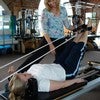Description
About This Video
Transcript
Read Full Transcript
Hello everybody. My name is Niedra Gabriel, and this is Kristi, well, too dear friend of mine, 25 years we've known each other, Pilates teacher, yoga teacher, nutritionist. And today I wanted to reel back a little bit about the fundamentals in Pilates, but more importantly in life, which is potentiating our trunk and our spinal column. This by the way, is wonderful work for beginners and super advanced people cause it takes you to another level of looking at what's going on with this body. So I always start, Kristi would you turn sideways to the camera and have a look at a client, and you can do this on Zoom, I've been doing it on Zoom for a year now, and have looked at the curves of the spine.
And when we normally train, we are either inflection or in extension. But what we really want is to create decompression in relation to gravity. If you look at most people, they have started to swing their hips a bit forward, which collapses the chest back a bit, and then the head goes forward. So there's always this flow of movement and you can come back to what's comfortable for you, and people adjust and compromise in relation to gravity. And when we're training ourselves and other, we're looking to go against the forces of gravity and restore optimization.
And it's very much about activating the powerhouse. So Kristi, I would like you on your hands and knees. So what we're doing here is we're potentiating all these stomach, I should say trunk muscles to make them optimally fire so then we can do exercise from this activated place. And the first place I look at is the lumbar spine, because this is where people get a lot of compression. And as you get older, there's a tendency to sink down.
And if I'm putting my hands on Kristi's back, I can feel the muscles a bit tight and grippy, beautiful athlete, but they're tight. So the first thing I'm gonna want her to do is really pull the stomach up just enough, too much to create, lift up here. So I'm lifting the top of the sacrum. So we get a flat back just to get the support in the front. Now, I also want a very wide back and notice it, now she's gone in a to a kyphotic spine where she's rounded.
So I want these wide, but now we need to get into this area where people are very tight. There's usually spasm tear and super tight here. So can you give me extension here and even more spread your shoulder blades, even more spread them, no apart bring the armpit too. So you can notice that she's very strong muscularly, but she actually, when she spread her shoulder blade, she's exposing the fact that the upper back is actually got a lot of tightness in it. It's stuck, so she's not using all of these muscles in anything, walking, exercise and so forth.
So we're looking to get as close to a straight spine as we possibly can so these upper back muscles fire, and the stomach muscles fire. So you want even more extension here, spread the shoulder blades. That's it, even more extension, So she's working really hard. We're beginning to get something to happen. I'm looking to get more length in the waist.
This is just kind of my goal don't tuck, don't tuck, just enough. So we're looking at this spine. We're looking to activate it. So this lumbar spine supported from the stomach and the back muscles in the upper extensor muscles are working to keep this decompression. Usually people are either here or here, but they're not potentiated.
So gonna do a little bit of release to make sure she has more softness and length. So Kristi, I'm going to give you ball. By the way, new thing, Yamuna black ball, but you can work with a tennis ball, yoga tune up balls, Franklin balls, just something because the deep abdominal muscles can get very tight. I want you to put this around your navel and just lie down. If a ball is really small, you can get a yoga block to elevate it.
And then bring your chest and your shoulders down, down to the mat, lie down on your belly. Like down, down, down, down, down. Once you have some kind of pressure pushing up in here, a lot of people go, oh my God, you can see the lumbar spine lengthen out. That's what we are looking for. How does this feel, Kristi?
(indistinct) easy, actually. It's feeLing amazing for her. So I'm looking, this is the goal. She's not tucking, she's not working hard. She's decompressing.
We want to potentiate that. Want you take the ball off to one side, so we're working a little bit off this, yep. And now lengthen the rib cage over the ball. So we got this ball conceptually here, and see if you can sink into this area. And normally I would spend maybe five minutes with a client.
Depends how tight they are. If they've never done this work before, it takes a little bit longer. Her muscles are beginning to relax. So we're actually getting into the back from the stomach. Now lift up a little bit and go to the other side.
And again. This looks like it's a little bit of your harder side. Yeah. Yeah. So she has a little more spasming, a little more chronic tightness on the left side of her, so as, and we like finding those places because it really like catapults the ability of the person to another level.
So I want you just to be aware of how your back feels right now, come back on your hands and knees. So we softened up the muscles a little bit. See if you can replicate that feeling in lower back. So it has to lift a little bit there, there. Good. Can you get the ribs up, pulling even more away from the hips?
Don't tuck. Do not tuck. Don't arch. (both laughing) That's the dance, don't arch, don't tuck. And now can you find these muscles and notice that she's still stiff in here.
A little bit more length happening here, but there's still stiffness here. So this is where we can bring in spine corrector or barrel or balls, or you can even take a yoga mat and you can roll it up. This is a little bit high. But Kristi if you turn it with your back to the camera, please. Back, back, back, back back.
We wanna look at your lovely back. If you look at the rib cage, it starts down here and rolls all the way up. And we have all these vertebra's coming up. And each one of those vertebra should be loose and mobilized. Most people have areas that are jammed in tight, and then they have a lot of mobility around it.
So it's very individual, but we want to get into those areas and really start decompressing them. So you will, let's start you at more at the top. We're starting here at the top. I want this part on the barrel. So we're getting the pressure.
We're taking either balls or a barrel of something. We're putting the pressure right into this area. Now notice the rib cage inflates. So we want to, I want you to give me a posterior tilt. Can you feel that?
So now she's lengthening her lumbar spine while she's really pressing into this area. Lift your arms to the ceiling, right. And keep that tuck. So for you, I think into a tight area, yeah? Yeah, (indistinct) a lot.
Yeah. And then, we're gonna stretch now. Right now, I'm letting the armpits come up. I'm not trying to keep the shoulders down. I want to expose the tightness so this pressure is starting to soften that whole area and widen it.
Because she, I think this is a lot her area and we all have our areas and we want to find them because it's gonna give us a much higher level of talent when we exercise. Bring the arms up and move an inch towards your head. So we're just micro moving through every bone in her back. Posterior tilt, so you tuck bring these ribs down, lift the arms to the ceiling, lift the armpits up. And now keep that posterior tilt.
Now she's locking, so we're lengthening into the lats, keeping this going down. So this cue that we often do of closing the ribs is really activated when you get extension in your back and lengthen the lumbar spine, it happens naturally rather than by force. So we're pulling these two platforms apart. Very nice, bring the arms up another inch. Posterior tilt.
You're looking to get these ribs down, and you lift and take the arms back. You will have clients that can't have their head. This is a bit of a deep arc. So clients that are stiffer and tighter, relax your head. You want to put a pillow so that you're finding the amount of arc that they're able to deal with, because what you're really dealing with, I know you can take it, is very tight muscle structure along the bones of the rib cage.
That's what we're going for so that their extension and natural posture is going to be on another level of youthfulness and vitality and vibrancy. And you're gonna move up a little bit more. And posterior tilt, think of this. Yes, and now lift this. So we're taking the bottom of the rib cage on the top and we are massively, yeah there.
You just opened up. That's awesome. And then we're finding the lats. You internally rotate in the armpits and you, I would like more length in the elbows, more length. There we go.
And let the shoulders come up because this exposes your serratus muscles and the whole side of the body. I think she's adding a three inches of length into her trunk right now. Keep the posterior tilt. Yeah, lovely. And come back up.
So if it's a smaller platform. Up you come to sitting, come back on your hands and knees. If you're working with a smaller ball situation, you can go even lower. But because it was a big arch, we're you staying with this? Let's see if you can get this nice, flat back.
Remember people compulsively crunch the shoulder blades together. I want lots of space here. Lots of space. Now let's get back extension first. Back extension, don't pull the shoulder blades together.
We need to get these on the side of the body, not in the back right now. So I want extension, extension. Even if you shorten here. There we go, we're starting. I can feel the tightness, but this is good enough for today.
Now let's have the lift in here. Lift that and lengthen, but lift up here, don't shorten. Lift, lift, lift, lift, lift. Better. So now we're starting to get closer to this straight spine and get more length in it.
So by now, your client has probably been working very hard and you're gonna lie on your stomach, because now we're gonna take it to the next level. We're going on to steroids. And once you up your elbows, this is pre-Palates, by the way. (Niedra laughing) We're now taking this whole ability to activate the trunk to a whole other level that will really wake up the transverse abdominis and the sensation of trunk control. So in this position, Kristi, I want a nice extension.
And this is the thing I want broad shoulder blades, but without this kyphotic. Do you see how she's rounding. The only way she thinks the shoulder blades can come forward is by making her back rounded, but that's not true. That's not how the body works. Better real big extension.
The feeling is almost like the armpits come forward. Good athletes have a huge range in the shoulder blade. Now, even more, bring this in, not up to the ceiling. This has to go into your body, into... Without this contracting.
Get your shoulder blades away from you. Bring this into your body. We're trying to get this upper back activated. That's good enough for now. I'll buy it.
Back at the neck long. Now, curl the toes under. Your knees stay on the ground without anything moving here. I want you to start pulling your stomach in and coming into a funny plank and your hips have to move backwards, but a little more, little more, just to there. Now, here here's the dance, stomach is up.
Lengthen this back. Don't take your head up. People think this is extension, it's got nothing to do. You see the weaknesses? Bring this to the floor.
Keep your shoulder blade wide and keep this lifting. Hold it even more flat, long, flat back. I think she's starting to really, really work hard in our abs. Now we are beginning to get a really intelligent trunk. She's shaking.
That's how hard she's working. And then you can relax. And it's real good to shake because we're waking up muscle patterns that you've never used, and you need them for good posture. So fatiguing them turns them on powerfully. And then you use them very nicely in all your Pilates workout, yoga workout.
Anything else you can come down, my dear. (Kristi sighs) (both laughing) Did you feel your abs? So much, yeah. This, by the way, just this turns on abs like you wouldn't believe it. Advanced people just come back and they go, oh, I never felt my abs like that.
And they were not tucking. They were really working the transverse abdominis, which we need. Now we are going to get to the next step. So now we have activated the transverse abdominis, which is the corset shaping of the muscles in relation to the upper back, which is so important just for pasture and life. So Chrissy I'd like you back on your hands and knees.
Now we're going to get into the obliques. And this by the way is all before we start working out. So I want that same long spine. So there's more intelligence. I want those shoulder blades spread.
You can sort out a lot of those winging, funny shoulder blades that people can have with this work. It's usually they just don't, the shoulder blades don't know where to go and they're problem-solving muscle groups that it's not their job to problem solve. I want you to spread your shoulder blades even more. I never knew you had such a flailing left shoulder blade. My goodness! Finding out things about you.
Lengthen more. Don't round, no rounding. She's constantly going into this kyphotic round shape. I want extension in your upper back and broadness in... There we go.
Nice. Nice, nice, nice. Now, we are starting to kick in the obliques and wake them up. So you've got this nice length in the trunk, nice length in the back. Can you, and if I put my hand here, there's no muscle tension.
I want it all here. So that we're wrapping around the spinal column in its most vulnerable area and not letting it get short. Which is really useful for healthy living. This elbow, you're going to lift it up to the side of your body. And did you feel how much you shifted?
Come back? So see if you can find all these qualities, so now we're turning on the slings of the body, the opposition, and a forces that have a very important for walking and all the imbalanced work that actually is most of our lives. So see if you can keep very active and then lift this hand up and you... Better. That was so much better.
Stay there, stay there. So this elbow needs to be lower than the shoulder because we're not looking into doing the arm work. We want the trunk. So now we've just cross force this diagonal in her body without anything changing in the elbow. I want you to start rotating to the left in your rib cage.
So she's bringing a rotational aspect into her body. Keep the extension in the spine. Keep the stomach muscles working. Bring yourself back down. Look how much she's cheating.
Oh, terrible. That elbow went way up. Nice, long, long, long, long rib cage, that's it. Keep the stomach pulling up and bend the other elbow without anything, put it back down. I can see her whole lower back sinking.
So I know the obliques are weak here. Keep this lifted and lift that elbow. And the elbow is lower than the shoulder. So we have a tendency to go back. We don't want that.
Now, without this changing start using your trunk muscles to rotate open, nice and slow. Watch that the elbow doesn't come higher. I want much more work in this low rib. Lift this rib up and come back. So this, I would have her, if she was my client, I would have her do it, and it would be a repeating theme.
But we're going to add more. (both laughing) Five pounds. If you have a lot of trouble doing this with nothing don't add weight, but I know she'll just have fun. So same thing you keep checking. Not rounded, not long lumbar spine, more length, lift up more, lift up more, lift up more, there.
Right now those those tight QL just released. Nice and long, spread the shoulder blades. Good girl, now very slowly lift that elbow. And as you lift the hand comes right under the elbow, under the elbow. So not too bent.
Keep the rib lifting. Now, just that. And now when you lift, do not lift the elbow to rotate, lift the low ribs. Pretty good. Very slowly come back.
She's dying by the way, and put the hand down, and we're gonna ask her what she felt. She went, she has to have a break. I'm sweating. Sweating, where are you feeling it? All, like I've never felt in my whole life, and I'm, yeah.
She's an athlete. Yes, it will turn on your... Wow. God, I blanked out on what they turn on. The transverse.
The transverse abdominis. Incredibly, my deary you're doing the other side. And then she'll be ready to start working out. So here we are. We've activated the lumbar spine by getting the transverse working.
Don't hike your shoulder up yet. Don't don't hold this yet. Don't hold this yet. We need the, always come back to this base. This is standing straight.
This is doing rode... Spread the shoulder blade so you have a really, space. Now, hold the weight and don't change anything and start to lift your elbow. Not too high with the elbow, because we don't want your... Lift this rib up, this rib.
Lift, there it is. There it is. Which has got mild scoliotic patterns going on. Now your rotation will come from here, not from the shoulder. So you can get the rib cage to rotate.
Rib cage. She's going, oh my God, oh my God, oh my God. This doesn't look like anything's happening. Keep going. And then bring the hands back and drop this down.
And just do anything, relax, because that's hard. This turns on your powerhouse like you wouldn't believe. I'm gonna do that everyday. She just said, "I'm going to do this every day." (both laughing) So she activated the obliques, which are these big powerful cross muscles in the waist area. And this area is again, an area that gets very tight and shortened.
So our rib cage in our hip starts to get closer and closer together as we get tight older, and they lose power. And they're very important parts for, of course, looking gorgeous at the beach and having a svelte waist, but factually functionally to have a good posture relationship between the lower and upper body. So roll back and then side stretching is an amazing to start to open up the tissue and expand it. So Kristi, please turn around, get your feet against the poles. And we will do one regular roll back, first of all, and then the single arm ones.
I'd like you to hold either side. And so now let's see how much we can activate what you just did. So don't work... Yes! Nice, soft back. But I want even more extension in here.
Nice. She just spread her shoulder blade. Give me more lift. There. There. So with nice, because what usually happens, people get a lift here and they get short here.
They length in here, they round here. That's the dance we want to get out of, and get even more length without... Don't shorten there, inside. Yes, beautiful. Now, lean back from your sit bones one flat line just to start.
Now, when you roll down, I'm more interested in the lumbar spine for you, 'cause we know you are vague, you can be kyphotic. So really bring the tail and slowly articulate yourself down to the mat. A and nice and long body. So see if you can feel both those planes, long lumbar spine, long thoracic spine, and then roll yourself up and see if you can keep an evenness there. And sit up nice and tall.
Now we'll go into the side bends. This is where we get to the obliques. One hand in the middle.
The hand that's holding the bar is what's pulling the body forward. So you do wanna watch that you're hitting the mat evenly on both sides. Have a look at your client that they're even, this is a side that's going to want to be short and roll up. This is a side. Imagine that you're getting a length and the waist.
Now this hand, stay down. This hand will come, I like it to go to the side right here. You'll see the client want to roll up. You want them flat, but not short. Then this hand comes up by the ears.
Then you lengthen the left side without shortening the right side. So again, much length start rolling to the right. You don't, you crunched way. No crunching on the right side, you want to length? Like you're a big tree growing...
That's it. That's it, so we want both sides long. And then you'll grab and you want to watch, because this is a side that gets rolled up and we want press the side into the mat. And then we'll take this left foot and you slide it across. You will find that your clients are doing all sorts of funny things.
So it's not that they're hurting themselves massively, but you want to in time flatten them out. It's as so they're doing this stretch against the wall. Bend this knee. Put it up and cross it over and slide it down. And I want you to feel that you're stretching from inside your stomach towards a weightless leg lengthens out.
You're reaching from the middle of your belly into the foot, from the middle of your belly up. We're now taking all of this connective tissue, there's a chain that runs all the way from your ankle to your wrist. And we're taking that band and we're opening it up and spending a little time here because it's so tight, and we're looking to make a lot of space between the hips and the ribs and a huge amount of space between each rib, and then maybe into the triceps in the outer arm. So to come back, my dear, you're gonna put the foot back against the pole. (both laughing) No Cadillac, swing your hand around and bring it to your waist.
I want you to find that long body. Get that length and see if you can articulate your way up. Get that long lifted spine and change side. So she's starting to get more and more length. This rib cage, I will eventually want, don't push, push, bring this in and get this even more lifted.
And where she's tight, and it's a bit out of the scope of the class today is right here in her serratus muscles. You are gonna roll down. Make sure you feel both sides of your body flat. Take your right hand to the side, bring it up by your ear pause here. Get more length than the right side, but don't shorten the left.
That was so good, she just got longer. Now keep that length and don't shorten here, but reach and lengthen even further. With the head rolled up. Did you see all those little wiggles you did. Those are little things that I yell at people for.
And you'll slide this leg across. So when you have a client that's going, and they're trying to fix themselves, so you do that. You really jumping over the tight spots. You try to get comfortable and you're missing the most important part. You want to like stay very alert, like molasses, moving through something and if you hit a barrier, stay there, 'cause that's where the connective tissue is tight, and it's not moving.
So you want to like have a relationship with it. So now slowly you bend your knees. Slow, slow, my dear. You soften the knee, slide it over. And now from here, you lengthen this leg out to get even more length into that side.
So most of the time there is a massive stretch on the side body. Chinese medicine, this is the liver line. Liver Meridian. Very good to open it up. They energizing once it's open.
Bring this leg back. Bring your body back. Bring your hand to your waist. Lift your head and roll yourself up and sit nice and tall. The other way you can start to loosen up this whole side body so there's even better posture, even better length, even better trunk control is working again with either rolled up yoga mat, a ball, a tennis ball.
And Chrissy lift this arm up for a minute. We have our back body and we have the front. There's a width to our body. So we just stretched out this side plane and all across here, there is a lot of tightness and connective tissue. And right here is the area of the obliques.
We're going to be rolling out this area of the waist and with the aspiration of getting a lot, a lot of space. So there's all this tissue that's gets tight and stiff, and then rolling up the sides of the rib cage to soften them up. So now let's have you back here. So you get it into the waste area. You want to feel as though you're sinking in, but you're pulling the ribs and the hips away from each other.
And you can also roll yourself a little bit forward and back and find those spots that you kind of feel tight and grippy. And each of us has our own spots, and it's really nice when we find them 'cause it gives a huge amount of spaciousness to the trunk and then power and rotational abilities. And it removes... Sometimes you can have a person whose hip is hiked up or they're twisted and tending more into scoliotic pattern. And those areas are part of what's holding the bones along those shapes.
Now let's have you roll up and place the ball higher up more along your bra line. This is a tighter area. So this whole area can be very interesting. So just roll back and forth a few times, moving into areas that feel tight. And come a little bit higher up again.
You can take a lot more time working here, but this is just, if I'm working with a client in a session and I'm seeing there's a juicy spot, they're not potentiating we take a moment, soften it up and then activate that area. Very, very good. Let's have you just sit up for a minute, swing your legs down and just let's see what you feel like. And if that side of your body feels... This side's taller.
She looks and she feels taller on that side. Let's have you quickly go on the other side. So just rolling out the waste a little bit. And moving up so the ball is under the area of the ribs. So of course, right now we're just using it as a little touch for the workout.
But if you really find areas that are tight spending time there on your own, two minutes to 10 minutes can completely change your physiology so the next time you come back to work out, you have a different body, don't we all love that. And a little bit higher. She just went aaw. So she's finding this whole upper rib cage, remember she's tightened the upper rib cage, she's tighten her back. So it's this whole band in this high area that this beautiful lady has a lot of restriction and talent that she can potentiate with this approach, discovering it, uncovering it, and then working with this new body that she's creating right now.
All right, let's have you come out of here. And back into your plank, your elbow. (indistinct) Yes. So first we find thoracic extension. So remember your shoulder blades are wide. You're not rounding in your upper back.
So you want to differentiate between the shoulders being wide and your, even more wide here, and that you don't need to collapse your chest. Your chest is lifting. Can you spread the shoulders? better even more. (indistinct) Yes.
Now she's starting to understand that differentiation. Lovely. Now very slowly you are going to start to lift the hips. Just to there, better back, better back. Now, our trunk is being supported by the trunk muscles versus compensatory muscles.
Now we're gonna take her to the next level. This takes about six lessons, by the way, what we're covering. You will vary, do not change anything. Stay in these muscle groups. You realize you just make yourself comfortable.
(Kristi laughing) You will slowly softly lift the knees, do not go to a straight leg position, but get off the knees just to there. So now she's acting more work into the powerhouse, and it is firing whole her body's being supported by her trunk muscles. And she's got a completely corseted body, and I'm gonna test something, but I bet you if I push into her, she's like a rock, which is what we want. We want really stable body. You can come down.
Good work. Okay, my dear. So just a little bit of movement. We'll now be stepping into exercises using whatever your modality is. It can be reformer, mat, but we will work with the Cadillac.
Kristi, please sit up. And we will go into push through bar routines, which are absolutely lovely. Usually more for flexibility than strength. Remember Kristi, we are looking to get a lot of lift in this part right in here. Can you give me even more extension, not roundness, extension.
That's better. So now she's learning to widen her shoulder blades, but even more lift in here. There we go. We're beginning to wake this upper back up and now pull the lumbar spine back even more, even more. There it is, beautiful.
Now that you're in a perfect shape, start rounding back, but keep that waist long. So you will be inflection, but you want a long waist. So I'm always looking with someone like her. Can we keep this waist really long and lifted? And then on the way back, I want you to spread and then open up the tissue in here.
And then lift up and lengthen, and now the longest spine you've ever existed found in your body, even more, look at this, it's beginning to decompress. Lengthen the neck too. Again, roll back. Broaden the shoulder blades and lift the stomach. So always I'm looking at this lifted long waist to decompress lumbar spine, and then coming back, broad lifted waist, extending up, lengthening, pulling the ribs away from the hips.
There. Just a tiny bit, we're pulling the back sacrum back, not tucking, one more time. So there's this fine line between tucking, where we're just working with hip flexors. and actually creating length in the lumbar spine. That's really what we want to differentiate in ourselves and in our clients.
Get as much length in that back. Beginning to really see some nice qualities coming in. Even more, even more into there, but keep the lumbar spine long, keep it long, keep it long and keep this rib back. Okay. Very good. Swing around to the other side.
So I know, even though she's a beautiful advanced practitioner that this upper back is where I would be going for to soften up to the next level. Let's have the palms of your hands down. This next part, I'm approaching completely to open up the shoulders because I know she's tight there, even though she's flexible and loose. So the first thing we're gonna do is spread the shoulder blades. Notice that the shoulders a cuff is coming forward so that we can expose this tissue.
Let's have you bend your elbows a little bit. But we're keeping the shoulder blades wide. So we're stretching this whole band of front of the arm in a way that'll give her a nice broad back. Now, start rolling back, keeping the head down, but keep this really rotated this way, and it'll start stretching into her pex in a beautiful way. And it won't affect her posture negatively.
I know we sometimes don't want those shoulders forward, but we're missing opening up parts of our body. Beautiful, come forward. Watch that you don't hyper extend your elbows, but keep this... There you go. So she's pulling this cuff down and then lift up as much as you can.
Can you spread your shoulder blades? Yes. There we go. So every time we're pulling it apart, she has a broader body. Bring the bar down. Lean back and give yourself a nice...
Good girl. I see you're internally rotating. That's what we want. We want that stretch and then come forward and lift the arms up. And I'm looking at the distance.
Can you lift up more here, the distance, in there, yes. Gymnast do lots of work to get this rotation. One more time, push down, press back, lengthening out, pull the lumbar spine, make it even longer. Yes. Oh, she keeps going longer, longer, longer, longer.
Look at that and then come forward and up. So we're using these exercises again to potentiate the whole body. You're gonna let go, lie down on your back for teaser. Hold the bar with your hands. Let's have the shoulders right under the hands.
Very nice. So find that long thoracic spine, long lumbar spine, long legs, pull the bar towards your face with the elbows wide and press the arms over your head. Keep your lumbar spine long. Lengthen the side ribs. Even more, even more.
Oh, look at that, another three inches. Bring the bar back. Straighten the arms and float to teaser. Up you come, and pull the bar behind your head three times, keeping the length in your upper backs. I want that upper back.
Two and three and lift up even more with the arms. Let the shoulders come up for a minute, and roll down keeping that open armpit. Nice. There's your double leg stretch. Pull through and extend.
Bring the bar back and lift up. And I want that upper, upper back long without roundness in here. A little bit good down in up the legs, lift them up, lift them up, lift them up, and roll down through the spine. One more time, pull back, lengthening out. Lengthen.
Bring the bar back and roll up. Longest back you could be, longest posture you could possibly have up through the neck and arms and legs together. One, two, three. Now, she will let go with both hands towards the feet, hands behind your back. This way and stretch over round out.
Of course, this is the advanced version. She is an advanced practitioners. Sweep the arms around and grab your feet and give yourself a lovely stretch. Now, right here, lots and lots of stretch in this part. I want the stretch in this part, it's this high part between the two shoulder blades that she has the least amount of awareness, how to activate.
So let's lift your body up a little bit to your left. Let's hold the top of your feet. I want you to get the length, but not through the neck. There we go. Cause people do this actually shortening because they're trying to fire.
Now, bring yourself down, keeping all of that. That's better. Stay long, stay long, stay long. Don't go lower than you can be long. Very nice, bring yourself up.
Beautiful, beautiful work. On your stomach for swan. I'll bring the bar down and you'll hold the bar with your hands. This is a fun one, because, turn your head to one side, right here people crunch their shoulder blades like crazy, which is a solution to a problem, but we want, so I like to keep people bring the armpits towards the floor. And now give me length, and a lot of tension just came out because now we're opening up the sides of the ribs in this very high area.
And I know that right here, she's gotten a lot better in this class. I want more softness. So when you bend your elbows to the side, pulling the bar behind your head, do not crunch your shoulder blades together. Just to there, just to there and take it back. So we're not going up yet.
When a person is really tight, they will have to crunch the shoulder blades together. So as a beginner, I let people do that. Once they're more advanced, I want this wide and bend the elbows and don't take the elbows too high. Now she's, what happened to those shoulder blades? Keep that back wide.
No higher than this with the hand, elbows up a little. Don't crunch your shoulder blades. Now we're stretching her pex, now she's finding out all the shortness in her upper front body and back down. Now you're gonna have fun and you're gonna come all the way up, but you're not gonna go all the way up cause we're gonna go into your tight spot. Bend.
Keep the shoulder blades wide, now start lifting. And I want the upper back to bend. Upper back, upper back, get this to work. Better, and now lift the armpits, lift the armpits. So I'm looking to activate into there.
Now you can lift the stomach up. Come up as high as you want to, but don't lose that. Drop your head down and come down. So... Open this area and now bend your elbows and come down.
So we want to wake this up. You're gonna have one more chance with the head in the other direction. Beautiful work. I yell at everybody. Even if they're fantastic and pull the bar behind your head shoulder blades wide, not...
Don't crunch. You wanna work these muscles. Now, lift your head a bit, lift your head and make this upper back work. Now it's starting to happen. 'Cause she has these shoulder blades that don't know where they belong, better.
Don't go any higher than this with the upper back. Now, can you lift the stomach lengthen the lumbar. Nice, now drop down and roll back. Stretch all the way out. I've got the bar.
You will sit back into child's pose and we will be going to the wall to finish out this workout. To finish We'll be doing the normal wall work, but with a little bit of an application of everything we covered. Traditionally, I used to emphasize pressing the back into the wall. And I'm now looking at the full spinal column. So the wall is just there as a guidance system for creating more trunk lengths.
So it's a same thing that we did before. I do want you to soften your knees a bit Kristi. Because people lock. They solve so many problems in the pelvis by tightening in the knees reflexively. And I just wanna get this trunk.
So it's not about getting the lumbar spine into the wall, it's getting it really long. I want to see the ribs into the wall without losing extension and even more length up in there. So this is actually very nice. She's starting to get a very long spine and that's beautiful. Now you will roll down to the floor.
So now we get into this articulation of the spine and really becoming aware of it. I would like you not to, you'll do it again. So we're gonna refine this movement and then roll up and see if you can get a sense of this lifting inside the middle of your body as you're stacking your spine all the way up. And I want energy from the abs going into the thoracic spine. Those are the two poles that you want to fire.
Most of the time, people on the opposite pose, lumbar spine, and some, just collapse. (Niedra laughing) And one more time now. Notice you have a length between this point and this point. So we want to not shorten that area. So not trying to be a small ball.
We're trying to get that length in the body, as it's rolling down with all the muscles, supporting the trunk. And then you roll up, keeping that those obliques length. Yes, very nice. Very nice. Very nice.
Now, don't forget the extension that has to start kicking in for that final lift. And in your case, eventually we want even more spaciousness in these area, which will be a separate class. (both laughing) But very beautiful long spine. Now, can you shift onto your feet. So there will be, you can use your hands behind you and just get onto your feet.
And now let's see, actually we didn't check, very good. Because now her hips are back on our heels. So the back chain of her body is holding her body weight and there's more natural lift coming in and she's not sitting into her back. When we started the class, she was actually sitting into her back, and now she's like exploding to the heavens. So thank you, Kristi.
I hope you all find this very, very useful. Play around with this. This is material that can take weeks to really turn on in your own bodies, but it's a game changer. You will feel amazing. And I hope you will never be the same again.
(both laughing)
Tower & Cadillac Workouts: Beginner Cadillac Workouts
Comments
You need to be a subscriber to post a comment.
Please Log In or Create an Account to start your free trial.
